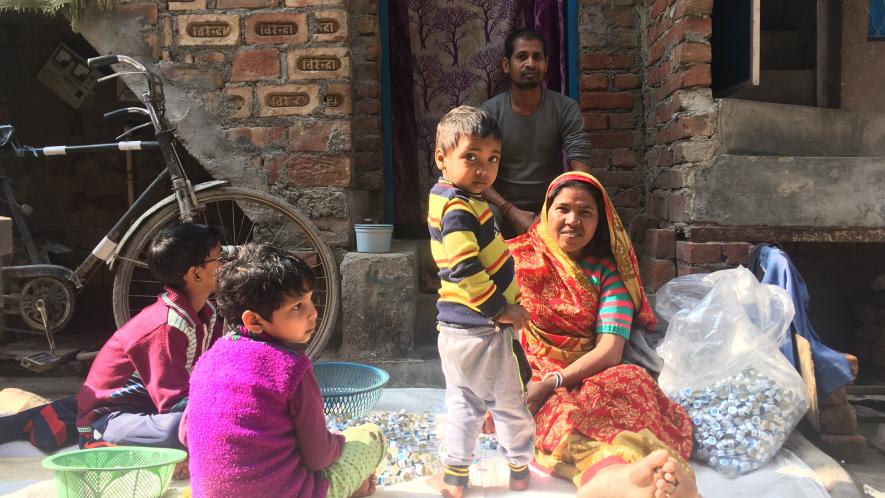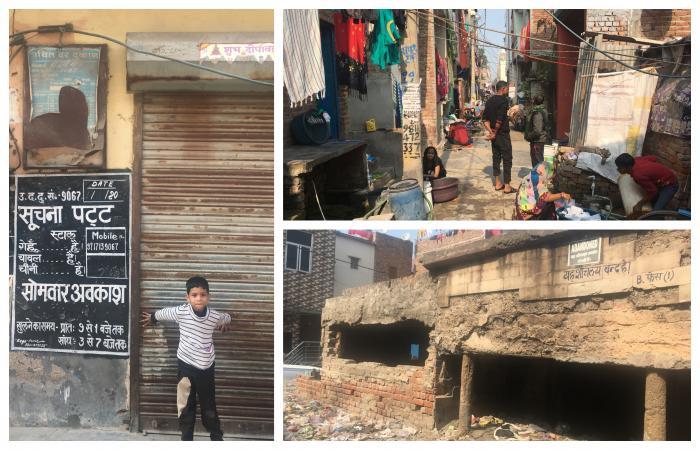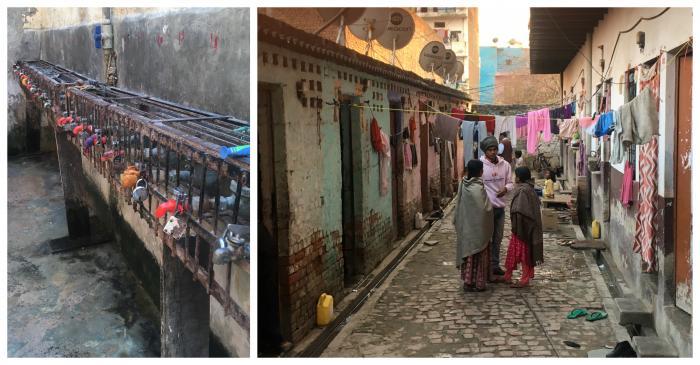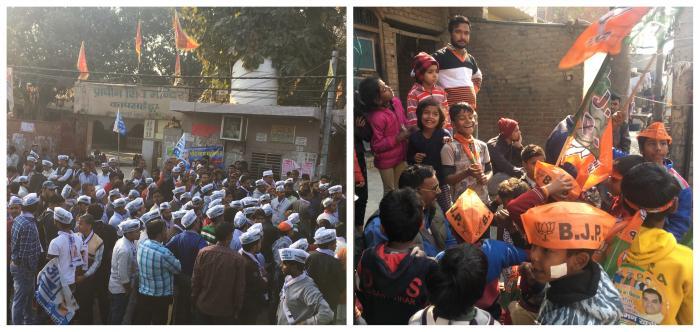Delhi Elections: No Cakewalk for Any Party, Workers Still Await Welfare Schemes

Brijesh (sitting in the back), a local resident in his thirties, with his wife and three children in front of their house in Narela's Metro Vihar.
Tucked in a remote corner of Delhi’s North West district, in Narela Assembly constituency, is Metro Vihar. However, unlike what the name suggests, the neighbourhood has nothing to do with the Delhi Metro or the facilities of a metropolitan region. It is a colony bordering Haryana, that houses workers who fulfil the employment requirements of the nearby Narela and Bawana industrial areas.
The nearest metro station, Jahangirpuri on the Yellow Line, is 15 kms away. The frequency of DTC buses, connecting Metro Vihar to the city, is as low as four a day. What’s near and the only well-connected site for the residents—mostly labourers—is their industrial establishment.
The region, that houses well over 50,000 industrial workers, is cut off from the national capital and perhaps that’s why it still awaits for a knock from any government schemes—both central and state—on its doors.
“What’s there for us,” asked Brijesh, a local resident in his 30s, and answered himself, “nothing.” A contractual worker in Bawana industrial area, he says, “Elections come and go, however, our lives have remained the same – actually gotten worse.” He speaks for many whose lives are sunk in despair.
Also read: Delhi Elections: Will Health Initiatives Bring Victory for AAP?
He manages to earn around Rs. 8,000 a month, that too, after working for 12 hours every day. His wife, a worker herself, is paid for piece work. She sticks liners in the plastic bottle caps. For 10 kgs of bottle caps—which requires a day’s work—she takes home a measly Rs. 50.
“Like everyone in Metro Vihar, I still pay for drinking water,” Brijesh told NewsClick, adding, “the ration shop is open only two days a month. The sewer lines are either clogged or broken.”

A child posing in front of a closed government ration shop in Narela's Metro Vihar (left). View of a lane in Metro Vihar, which houses labourers who work in the nearby industrial areas (right above). An abandoned community toilet in Phase 1 locality of Metro Vihar (right below)
Only a few homes away, Rakhi, a 20-year old who’s looking for a job, complained about the absence of toilets in the locality. “There was just one community toilet, which, too, is now abandoned,” she said. For this reason, she is forced to defecate in the open, she added.
After winning the 2015 Assembly elections, bagging 67 out of 70 seats, the Arvind Kejriwal–led Aam Aadmi Party (AAP) has over the last five years established itself as a new bandwidth of alternative politics in India. This time, as the national capital is set to go on polls on February 8, the party is flaunting its report card – giving high marks to education, health and water.
However, these aspects fail when it comes to the regions surrounding the many industrial establishments in the capital. Pushed to the outskirts, a visit to any of these neighbourhoods brings out the short falls of the AAP – otherwise known for its progressive policy engagement.
In Kapashera of South Delhi’s Bijwasan constituency, another locality housing labourers, many are still burdened by electricity and water charges, despite the AAP government waiving tariffs on both to a certain level – up to 20,000 litres of water and 200 units of power every month.
“Forget free electricity or water, the charges here [in Kapashera] are more than the usual rates,” said Sonbharti, 25, who pays as much as Rs. 8 for every unit of electricity and Rs. 100 for every thousand litres of water that he consumes.
Also read: Delhi Elections: BJP Lost in Its Own Labyrinth
A labourer in a garment factory in Haryana’s Udyog Vihar Industrial Area, Sonbharti said, “BJP promised us acche din, and here we are in a condition worse than before; AAP promised us free basic amenities, and here we are still paying for it.” The words captured the sentiments prevailing in colonies covering industrial constituencies which include Badarpur, Okhla and Najafgarh, among others.

Locked water taps in Bijwasan's Kapas Hera, where residents are still charged for consuming water (left). Housing lodges in Kapas Hera where labourers, mostly young, reside (right).
With only few days left now, the campaigns of the political parties have hit the roads in these constituencies. But behind the pomp and show of the rallies of political parties, lies a silence maintained by the three main contenders—AAP, BJP and Congress—on several issues, the heat of which is being faced the residents of labour colonies.
Bharat, a workers’ activist in Narela, explains this while speaking to NewsClick. “The ongoing economic mess, furthered by the policies of BJP, have broken the backs of many. The wages are falling and the prices of daily use items are skyrocketing. The industrial workers know whom to blame for it.”
However, with AAP failing to alleviate their distress, industrial workers—who are oppressed by the policies of BJP—now feel neglected and betrayed by the Kejriwal government, he added.

A political rally in Bijwasan's Kapas Hera by the AAP (left). In Narela's Metro Vihar, BJP seeks participation by the kids in a local political rally (right).
Anjali Bhardwaj, a RTI activist and also a part of Rozi Roti Adhikar Abhiyan Delhi, agrees. “The AAP government in Delhi did an appreciating job in terms of introducing social welfare schemes. However, in absence of a grievance redressal law, the efficacy of the schemes reduces, as there is nowhere to go and complain when they cannot avail the benefits of the scheme,” she said.
“To empower the people, we demanded a Right to Grievance Redressal Law which remains unfulfilled, both by the central BJP and the state’s AAP government,” Bhardwaj added.
Despite all this, the election campaign of the incumbent AAP government revolves around the bread and butter issues, even in regions where its schemes have not reached. The BJP, on the other hand, has fallen back on its divisive strategies, offering nothing more than communal campaign.
The third contestant in this electoral fight is Congress, which is banking on past achievements. The party is challenging BJP over mounting unemployment and making an attempt to expose AAP over its unfulfilled promises. However, with a sluggish campaign on ground and offers of next to nothing, Congress seems to be failing to woo the voters in the industrial workers–dominated neighbourhoods.
In other words, it will be not be a cakewalk for the political parties, especially in the outskirting areas of the metropolis.
Also read: How DDA has Failed Delhi’s Working Class
Get the latest reports & analysis with people's perspective on Protests, movements & deep analytical videos, discussions of the current affairs in your Telegram app. Subscribe to NewsClick's Telegram channel & get Real-Time updates on stories, as they get published on our website.
























